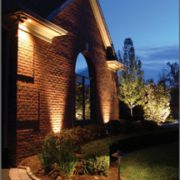Landscape Lighting Plan: Showcasing Your Garden’s Beauty After Dark
Why a Landscape Lighting Plan? Your garden is a living, breathing masterpiece you’ve carefully nurtured and designed to reflect your unique taste and vision. Why let its beauty fade when the sun sets? Landscape lighting can elevate your outdoor space by showcasing your garden’s key features after dark, enhancing safety and navigation, and creating a captivating nighttime visual experience.
When designing a landscape lighting plan, it’s crucial to consider factors such as the size and layout of your garden, the types of plants and features you wish to showcase, and the desired atmosphere you want to create during nighttime hours. A well-thought-out lighting scheme should strike a balance between aesthetics, functionality, and safety, ensuring that your outdoor space is both visually stunning and navigable at night.
In this blog post, we’ll provide valuable tips and best practices for designing a landscape lighting plan that highlights your garden’s beauty, improves security, and sets a mood for relaxation, entertainment, or simply enjoying the splendor of your outdoor domain. We’ll discuss fixture selection, placement, and techniques for achieving various lighting effects, as well as strategies for incorporating energy-efficient solutions that minimize electricity consumption and environmental impact.
By following these landscape lighting plan design guidelines and enlisting the help of Charlotte Lighting & Hardscapes’ professional team, you can illuminate your garden and bask in its enchanting glow all year round.
Landscape Lighting Plan Techniques: Creating Depth and Dimension with Shadows, Silhouettes, and Glows
Achieving a striking and visually appealing landscape lighting plan design involves strategically combining various lighting techniques to highlight your garden’s unique features and create depth, dimension, and intrigue. Here are four popular landscape lighting techniques to consider incorporating into your overall design:
- Uplighting: Placing lights at ground level and directing the illumination upward can accentuate trees, statues, or other vertical elements within your landscape. This technique creates an eye-catching, dramatic effect, focusing attention on these features.
- Downlighting: Fixtures placed above or on high points, such as tree branches or structures, cast subtle, natural-looking light downward, mimicking moonlight and providing gentle, ambient illumination. Downlighting is ideal for creating a calm and relaxing atmosphere while highlighting seating areas, walkways, and small water features.
- Shadowing: By positioning lights in front of your landscape features and aiming the illumination at a nearby wall or surface, you can cast intriguing shadows that accentuate the shapes and textures of these elements. Shadowing works well for highlighting shrubs, ornamental trees, and distinctive plantings.
- Silhouetting: If you have a distinct or unique garden element, such as a statue or interesting shrub, situate a light behind it and direct the illumination towards an adjacent surface to create a striking silhouette, emphasizing the shape and form of the feature.
Fixture Selection: Choosing the Right Landscape Lights for Your Garden
Selecting the appropriate fixtures for your landscape lighting design significantly impacts the overall aesthetic, functionality, and longevity of your system. Consider these popular fixture options when designing your landscape lighting:
- Path Lights: Position lights along the edges of walkways, driveways, and garden paths to ensure safe navigation and contribute to a welcoming atmosphere. Select fixtures that complement your landscape’s overall design and incorporate energy-efficient bulbs for a cost-effective solution.
- Spotlights: Use spotlights to direct intense, focused light onto specific landscape elements, such as statues, fountains, or exceptionally beautiful plants. Choose spotlights with adjustable heads for greater control and adaptability to changes in your garden’s layout and composition over time.
- Deck, Step, and Recessed Lights: Improve safety and highlight your outdoor living space by integrating deck, step, and recessed lights into your landscape lighting design. This approach provides adequate illumination without overpowering the surrounding environment and maintains a clean, polished aesthetic.
- In-Ground Lights: To create an enchanting, ethereal glow, install in-ground lights beneath your landscape elements, such as flower beds, low shrubs, or groundcover. Subtle illumination from these hidden fixtures enhances the colors and textures of your plantings while contributing a soft, romantic ambiance.
Energy-Efficient Landscape Lighting Plan: Sustainable Solutions for Your Illuminated Garden
When designing your landscape lighting plan, energy efficiency is an important factor to consider, both from an environmental and cost-saving perspective. Implement these strategies to reduce power consumption and ensure sustainable illumination:
- LED Lighting: Select LED lights for your landscape lighting system, as they consume substantially less energy than traditional incandescent bulbs and last significantly longer, reducing replacement costs and maintenance requirements.
- Solar-Powered Lighting: Harness the sun’s energy to illuminate your outdoor space by opting for solar-powered light fixtures. Available in various styles and designs, these energy-efficient alternatives require minimal installation and maintenance and are an environmentally friendly solution for your landscape lighting needs.
- Smart Controls and Timers: Integrating timers, dimmers, and smart control systems into your landscape lighting design allows you to manage and customize your illumination settings, conserving energy and extending the life of your lighting system.
Landscape Lighting Plan Maintenance: Ensuring Longevity and Performance in Your Illuminated Garden
Establishing a routine maintenance schedule for your landscape lighting system is crucial for preserving its aesthetic appeal, functionality, and safety. Keep these maintenance tips in mind to ensure reliable performance and longevity:
- Clean Fixtures and Lenses: Regularly clean your light fixtures and lenses to remove dirt, leaves, or other debris that could obstruct the light output, ensuring your garden remains beautifully illuminated.
- Prune and Trim Plants: As your garden grows and evolves, prune and trim plants near your light fixtures to prevent overcrowding and ensure optimal illumination. Reshape your landscape lighting configuration when necessary to accommodate changes in your garden’s composition.
- Inspect Wiring and Connections: Periodically examine your landscape lighting system’s wiring and connections, resolving any issues before they escalate and impact your garden’s nighttime appearance or pose safety hazards.
Final Thoughts
Designing exquisite landscape lighting requires a thoughtful balance of aesthetics, functionality, energy efficiency, and ease of maintenance. By following these expert tips and seeking professional guidance from the team at Charlotte Lighting & Hardscapes, you can create a captivating outdoor space that showcases your garden’s beauty and offers an inviting, illuminated refuge for relaxation, entertainment, or admiration. Message us today for a consultation with a landscape lighting specialist!
learn more about a landscape lighting plan at wiki
Get a free consultation on your landscape lighting plan














